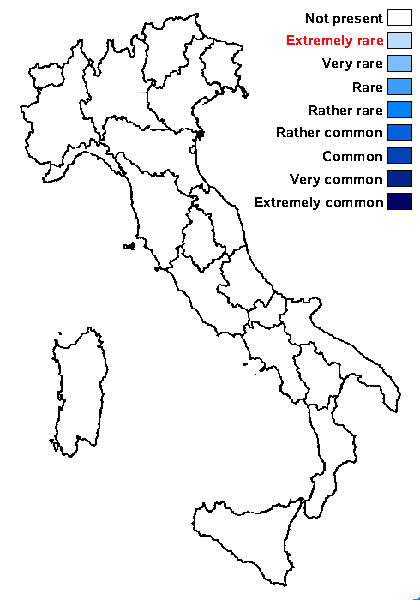Normandina acroglypta (Norman) Aptroot
in Wirth, Flechtenflora, 2 Aufl.: 634, 1995. Basionym: Thelidium acroglyptum Norman in Fries - Bot. Not.: 154, 1868 (1867).
Synonyms: Lauderlindsaya acroglypta (Norman) R. Sant.
Distribution:
Description: Thallus crustose, episubstratic, pale grey, diffuse, consisting of granular, sometimes effigurate areoles (the lobes, when developed, 60–250 μm wide), and scattered, diffuse 60-250 μm thick soredia. Perithecia black, 0.2-0.4 mm across, semi-immersed in thallus, the ostiolar region distinctly depressed. Exciple reddish brown but irregularly pigmented; involucrellum absent; hamathecium of periphyses, interascal filaments absent; hymenial gel I+ red (I+ yellowish or blue at low concentrations of I), K/I+ blue. Asci 8-spored, clavate, short-stalked, with delicate walls, K/I-. Ascospores (3-)5-7-septate, hyaline, ellipsoid-fusiform, (23-5)27-37(-43) x (5-)6-7.5(-8.5) μm. Photobiont chlorococcoid. Spot tests: thallus K-, KC-, C-, P-, UV+ orange-pink after heating. Chemistry: two unidentified terpenoids (without zeorin).Note: on bark and mossy siliceous rocks. Orange (2022) described N. acroglypta as occurring over rock and N. chlorococca over bark, but all three Norwegian specimens of N. acroglypta included in his phylogeny occurred over bark (Svensson & al. 2024), so that the difference in substrate does not appear to be diagnostic. The species is known from Austria, and should be looked for also in Italy.
Growth form: Crustose
Substrata: rocks
Photobiont: green algae other than Trentepohlia
Reproductive strategy: mainly asexual, by soredia, or soredia-like structures (e.g. blastidia)
Most common in areas with a humid-warm climate (e.g. most of Tyrrenian Italy)
Commonnes-rarity: (info)
Alpine belt: absent
Subalpine belt: absent
Oromediterranean belt: absent
Montane belt: absent
Submediterranean belt: absent
Padanian area: absent
Humid submediterranean belt: absent
Humid mediterranean belt: absent
Dry mediterranean belt: absent

Predictive model
Growth form: Crustose
Substrata: rocks
Photobiont: green algae other than Trentepohlia
Reproductive strategy: mainly asexual, by soredia, or soredia-like structures (e.g. blastidia)
Most common in areas with a humid-warm climate (e.g. most of Tyrrenian Italy)
Commonnes-rarity: (info)
Alpine belt: absent
Subalpine belt: absent
Oromediterranean belt: absent
Montane belt: absent
Submediterranean belt: absent
Padanian area: absent
Humid submediterranean belt: absent
Humid mediterranean belt: absent
Dry mediterranean belt: absent

Predictive model
 Index Fungorum
Index Fungorum
 GBIF
GBIF

